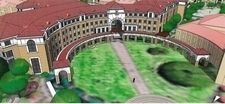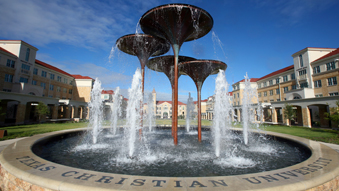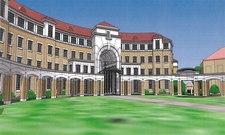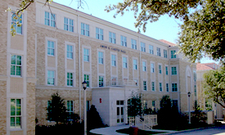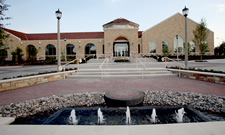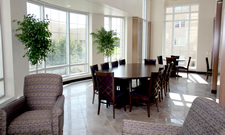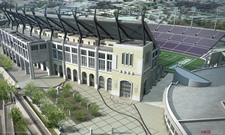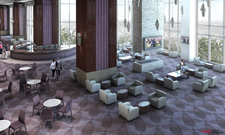New Campus Facilities
|
|
|
|
|
|
Transformed campus, all new or renovated buildings with a sleek football stadium to come
Utility work is under way in Worth Hills for two new residence halls to help meet student demand for on-campus housing. With a total of 400 bed spaces, the halls will have a variety of room layouts, study areas, meeting rooms and state-of-the-art amenities. Construction of the facilities will begin in May 2012 and will be completed by Fall 2013. The residence halls will be LEED certified.
Across Stadium Drive, the $100 million Campus Commons project has transformed TCU, creating an environment rich in personal interaction where intellectual vitality and social engagement intersect; developing an eclectic living environment where students of different cultures and values learn from one another; reclaiming the university's history of a residential, pedestrian-friendly campus; and providing expanded facilities for excellent academic programs.
"The Commons, consisting of the Brown-Lupton University Union at one end and Scharbauer Hall at the other, also includes four new residence halls, and a grand, open greenscape, and has become the core center of activity for campus. The award-winning Union complex houses the University's main dining facility, a 600-seat ballroom, a 350-seat auditorium, a retail copy center, and the campus post office.
In recent years, TCU has invested more than $500 million in new facilities and upgrades to campus classrooms, laboratories and residence halls and increased campus facility square footage to 3,495,971 from 2,273,021 in 1994.
Video tour of new facilities
Experience what it's like to walk through the newest facilities on campus and view the amenities each has to offer.
|
Residence Halls |
Brown-Lupton University Union |
|
|
|
|
|
|
|
New facilities over the past four years
After a months-long renovation project, the former Ballet Bldg. re-opened in September 2011 as Erma Lowe Hall, home of the School for Classical & Contemporary Dance. Built in 1921 as the University gymnasium, the structure was completely gutted to the exterior walls and support columns then redesigned with all the amenities of the 21st century. Architects Gideon Toal envisioned a somewhat industrial “New York loft” look for the new spaces housing studios, offices, workrooms and lounge areas.
The amenities for dance faculty, students and visitors now include:
Elevator
Water fountains on every floor
Wall insulation
Utility closet and sink for housekeepers
Spacious tiled locker rooms for students with multiple showers and sinks
A lounge area with adjacent kitchen facilities
26-station computer lab
LCD screens throughout the building
Public restrooms for guests attending performances
Well-equipped prop room and costume shop
Although there is still access through the original doorways facing S. University Drive, the main entrance is now on the west side, adjoining the visitors parking lot.
Following the implosion of the west grandstand of Amon G. Carter Stadium on Dec. 5, 2010, a $105 million renovation project is transforming the facility into the "Camden Yards" of college football facilities. Built in 1930, this is the first major renovation to the stadium since the upper deck was added in 1956. Designed by HKS Sports & Entertainment Group, who most recently completed work on the Cowboys Stadium in Arlington, the renovation greatly enhances the fan experience by improving stadium accessibility, seating and views of the playing field. The renovation consists of:
- Significantly upgraded and new concession stands for better access and reduced wait times
- Elevators and escalators to better facilitate stadium accessibility and crowd flow
- A new, raised seating bowl on the west and north end for enhanced field views
- Upgraded and additional men's and women's restrooms
- Suites, club seating and lounges on the west side of the stadium
- A new press box
According to Dan
Phillips, AIA, senior designer with HKS, the design references the
1930s style of Southwestern art deco prevalent throughout Fort Worth
and the surrounding region. "Through research, we discovered that Amon
G. Carter Stadium's original design intent incorporated this
architectural style. However, it was not fully realized. The new design
blends seamlessly with the Meyer-Martin Athletic Complex, the TCU
campus and the city of Fort Worth." For a look at the history and
future of the stadium, including architectural renderings of what it
will become, go to http://www.stadium.tcu.edu/gallery.asp
In November 2011, TCU received approval from its Board of Trustees' Executive Committee (acting on behalf of the Board of Trustees) to renovate the east side of Amon G. Carter Stadium immediately following the conclusion of the 2011 football season.
The east side renovation will enable TCU to have a fully renovated Amon G. Carter Stadium in time for the 2012 season, which marks the Horned Frogs' first year in the Big 12 Conference. Capacity for the completed Amon G. Carter Stadium will be 45,000 with expansion opportunities that could allow for 50,000 or more in the future.
The new east side will feature a double deck similar to what has been created in the north end zone. The height of the upper deck will be at the level of the speakers that currently sit on the light poles of the existing stadium.
The $7.9 million, 14,500-square-foot Mary Wright Admission Center opened in August 2010. Since 2005, the Office of Admission has seen a 50 percent increase in all visitors and an 81 percent jump in daily visits. TCU anticipates bigger crowds with the opening of this attractive free-standing facility at the corner of Stadium Drive and Bellaire with plenty of parking for prospective students and their families.
After a a year-long renovation process, 300-bed Milton Daniel residence hall in August 2010 emerged as the pristine new home of about 240 first-year and 60 upper-class students from the John V. Roach Honors College. The building will be given a LEED (Leadership in Energy and Environmental Design) gold certification. Milton Daniel follows renovations to Sherley, Clark, Waits and Foster residence halls, which took place over the last six years. Colby Hall is soon to follow.
Scharbauer Hall was built in 2009. The academic building is the 73,000 square-foot home for the AddRan College of Liberal Arts and the John V. Roach Honors College. The building opened for classes for the spring 2010 semester. The facility is a Gold U.S. Green Building Council's Leadership in Energy and Environmental Design (LEED) certified facility. Two bronze statues, John the Baptist and Madonna and Child, have been loaned to the College and are on display in the lobby. Across the courtyard at the rear stands Reed Hall which re-opened in Summer 2010 after a complete facelift that matches the look and feel of Scharbauer.
TCU's physical plant web site contains detailed information about the Campus Commons project and other university facilities, such as the College of Education building renovation and addition. The two-story, 34,000-square-foot TCU Barnes & Noble bookstore, located at the corner of W. Berry Street and University Drive S., opened in spring 2008. Clark Hall underwent renovations to provide 220 bed spaces in a mixture of room types. The building also boasts new common areas, study areas and improved accessibility at the entrances. Jarvis Hall underwent renovations to house university offices previously located in the Brown-Lupton Student Center and more. In Spring 2008, Sherley Hall underwent renovations to make the residence hall more accessible and compatible with other facilities and meet student residential expectations. It was complete in the summer of 2009 and was designed for US Green Building Council's Leadership in Energy and Environmental Design (LEED) certification. The Schieffer School of Journalism completed a new Convergence Center to enhance learning. The Athletic department also added state-of-the-art sports facilities when it completed the Sam Baugh Indoor Practice Facility & Cox Field and the Dutch Meyer Athletic Complex and Abe Martin Academic Enhancement Center. It continues its commitment to quality facilities with the addition of the Jane Justin Soccer Fieldhouse in June 2010. TCU broke ground on the new Mary Wright Admission Center in late December 2009 to create a better entrance to the campus and location for prospective students and families.
Parking Information/Road and Sidewalk Closures/Shuttle Schedules
As construction continues, this site will be updated with information about parking lot changes/closures. Additionally, information on road and sidewalk closures, shuttle schedules, a campus map and archives of information also can be viewed from this page.










